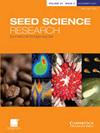从萌芽到幼苗发育:烟雾对塞拉多一种本地和入侵禾本科植物的影响
IF 1.9
3区 生物学
Q2 PLANT SCIENCES
引用次数: 0
摘要
巴西塞拉多是一个新热带稀树草原,是一个容易发生火灾的生态系统,其底层生物量主要由禾本科植物组成。然而,对于其他稀树草原,火灾线索(如烟雾)对塞拉多草的影响并没有呈现出明确的模式,无论是发芽还是幼苗发育。烟雾可以刺激植物生命周期的不同阶段,从而改变群落和入侵过程。到目前为止,大多数关于该主题的研究都集中在发芽上,而没有涉及植物发育的敏感阶段——发芽后阶段。在这里,我们研究了烟雾对塞拉多常见的一种本地(Echinolaena inflicxa)和一种入侵(Urochloa decumbens)草种的影响。在将种子暴露于干烟中5、10、15或20分钟后,我们分析了发芽参数以及幼苗质量和长度。在培养发芽种子3、7或15天后,通过测量芽和根系来评估幼苗发育。烟雾不影响发芽率。然而,熏蒸降低了两个物种的平均发芽时间和E.inflicxa的发芽开始时间。在所有栽培期中,伞形花序的长度值都较高,而质量值仅在15d时超过了弯折E.inflicxa。烟雾暴露降低了伞形花序7天幼苗的地上长度和两个物种15天植株的质量。此外,在不同的栽培时期,烟雾增加了本地物种和入侵物种的根系投资。因此,研究发芽后幼苗发育的参数可能会进一步深入了解烟雾效应。本文章由计算机程序翻译,如有差异,请以英文原文为准。
From germination to seedling development: the effects of smoke on a native and an invasive grass species of the Cerrado
The Brazilian Cerrado, a Neotropical savanna, is a fire-prone ecosystem where the ground layer biomass consists mainly of graminoids. However, as for other savannas, the effects of fire cues (such as smoke) on Cerrado grasses do not present a clear pattern, either for germination or seedling development. Smoke can stimulate different stages of the plant life cycle, which can alter the community and invasion processes. So far, most research on the subject focuses on germination, not addressing post-germinative phases, a sensitive stage of plant development. Here, we investigated the effect of smoke on a native (Echinolaena inflexa) and an invasive (Urochloa decumbens) grass species common in the Cerrado. We analysed germinative parameters and seedling mass and length after exposing the seeds to dry smoke for 5, 10, 15 or 20 min. Seedling development was assessed by measuring shoot and root systems after cultivating germinated seeds for 3, 7 or 15 d. Smoke did not affect germination percentages. However, fumigation reduced the mean germination time of both species and the germination onset of E. inflexa. U. decumbens had higher length values in all periods of cultivation, whereas mass values only surpassed that of E. inflexa at 15 d. Smoke exposure reduced the aboveground length of 7-d seedlings of U. decumbens, and mass of 15-d plants of both species. Also, smoke enhanced the root investment of the native and invasive species in different cultivation periods. Therefore, studying post-germinative parameters on seedling development may bring further insights into the smoke effects.
求助全文
通过发布文献求助,成功后即可免费获取论文全文。
去求助
来源期刊

Seed Science Research
生物-植物科学
CiteScore
3.60
自引率
4.80%
发文量
23
审稿时长
>12 weeks
期刊介绍:
Seed Science Research, the official journal of the International Society for Seed Science, is a leading international journal featuring high-quality original papers and review articles on the fundamental aspects of seed science, reviewed by internationally distinguished editors. The emphasis is on the physiology, biochemistry, molecular biology and ecology of seeds.
 求助内容:
求助内容: 应助结果提醒方式:
应助结果提醒方式:


